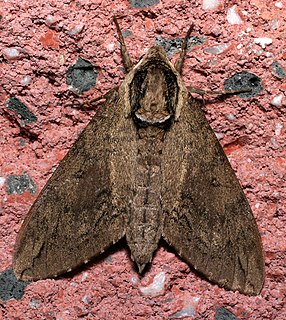
Ceratomia is a genus of hawkmoths. The genus was erected by Thaddeus William Harris in 1839. Species include:

Ceratomia amyntor, the elm sphinx or four-horned sphinx, is a North American moth in the family Sphingidae. The species was first described by Carl Geyer in 1835. It has a wingspan of 3+1⁄4-4+1⁄2 inches. As the name suggests, the larvae (caterpillars) feed on elm trees (Ulmus), but they can also be found feeding on birch (Betula), basswood (Tilia), and cherry (Prunus). When the caterpillars are ready, they crawl to the bottom of the host tree, where they crawl underneath the soil and pupate and may overwinter underground if late enough into the year. Vegetable growers should be aware of this larvae due to its insatiable appetite. One of these larvae are capable in devouring huge amounts of plant's foliage and even succulent stems.

Conchylodes is a genus of snout moths in the family Crambidae. The genus comprises 21 species and is placed in the tribe Udeini.
Corynitis is a monotypic moth genus of the family Erebidae. Its only species, Corynitis penicillalis, is found in Rio de Janeiro, Brazil. Both the genus and the species were first described by Carl Geyer in 1832.
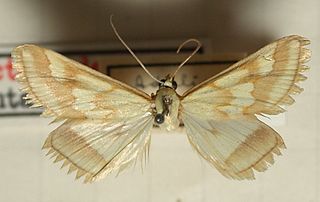
Ephelis cruentalis is a species of moth in the family Crambidae. It was described by Carl Geyer in 1832. It is found in southern Europe, from France east to Italy and Greece to Turkey and further east into central Asia.

Tetragonus catamitus, the common butterfly moth, or Philippine callidulid moth, is a moth of the family Callidulidae. It was first described by Carl Geyer in 1832. Noted from Taiwan, north-eastern India, south-west India, the Andaman and Nicobar Islands, Sri Lanka, the Tenasserim Hills of Myanmar and from Java. They are day-flying moths that can be easily mistaken for a butterfly due to the position in which they hold their wings.

Doryodes bistrialis, the double-lined doryodes moth, is a moth of the family Erebidae. The species was first described by Carl Geyer in 1832. It is found in the eastern United States, including Delaware, Virginia, Mississippi and Florida. Its habitat consists of wet pine flatwoods and pine savannas.

Diachrysia balluca, the green-patched looper, is a moth of the family Noctuidae. The species was first described by Carl Geyer in 1832. It is found in north-eastern North America from Nova Scotia west to Manitoba and south to western North Carolina. Great Smoky Mountains National Park is the southern limit of this species. The only other records in the south are from the type locality of Georgia and a record from Liberty County in north-western Florida. These possibly represent strays.
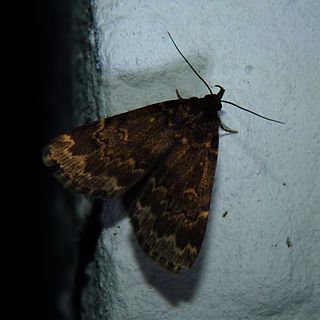
Idia lubricalis, the glossy black idia, is a litter moth of the family Erebidae. The species was first described by Carl Geyer in 1832. It is found from Canada south to Florida and Texas in deciduous forests.
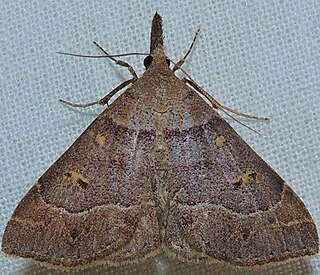
Renia flavipunctalis, the yellow-dotted renia, yellow-spotted renia or even-lined renia, is a litter moth of the family Erebidae. The species was first described by Carl Geyer in 1832. It is found from southern Canada to Florida and Texas.
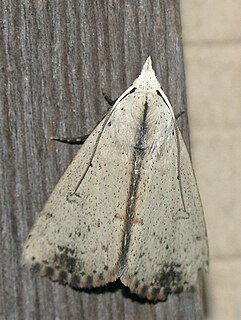
Scolecocampa liburna, the dead-wood borer, is a moth in the family Erebidae. The species was first described by Carl Geyer in 1837. It is found in the US from southern Wisconsin and Michigan to central New England south to Florida and Texas.
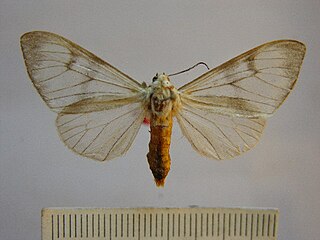
Dysschema amphissum is a moth of the family Erebidae first described by Carl Geyer in 1832. It is found in south-eastern Brazil, ranging from southern Minas Gerais and Rio de Janeiro, south to Rio Grande do Sul.
Saurita astyoche is a moth in the subfamily Arctiinae. It was described by Carl Geyer in 1832. It is found in Suriname and Rio Grande do Sul, Brazil.
Uranophora jynx is a moth in the subfamily Arctiinae. It was described by Carl Geyer in 1832. It is found in Paraná, Brazil.

Conchylodes ovulalis, the zebra conchylodes moth, is a moth in the family Crambidae. It was described by Achille Guenée in 1854. It is found from the United States, where it has been recorded from Pennsylvania to Florida, west to Arizona, south through Mexico and Costa Rica to Colombia.
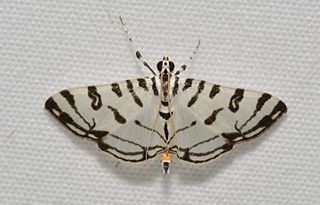
Conchylodes platinalis is a moth in the family Crambidae. It was described by Achille Guenée in 1854. It is native to Central and South America, where it has been recorded from Venezuela, Belize, Costa Rica and Honduras.
Conchylodes salamisalis, the blush conchylodes moth, is a moth in the family Crambidae. It was described by Herbert Druce in 1895. It is found in Ecuador, Costa Rica, Panama, Guatemala, Mexico and the southern United States, where it has been recorded from Texas.
The Miss Iowa's Outstanding Teen competition is the pageant that selects the representative of the U.S. state of Iowa in the Miss America's Outstanding Teen pageant.
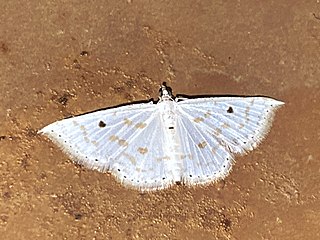
Derambila lumenaria is a moth of the family Geometridae described by Carl Geyer in 1837. It is found in Sri Lanka, India and Sundaland.
Leptostales laevitaria, the raspberry wave moth, is a species of moth in the family Geometridae. It was first described by Geyer in 1837 and it is found in North America.













